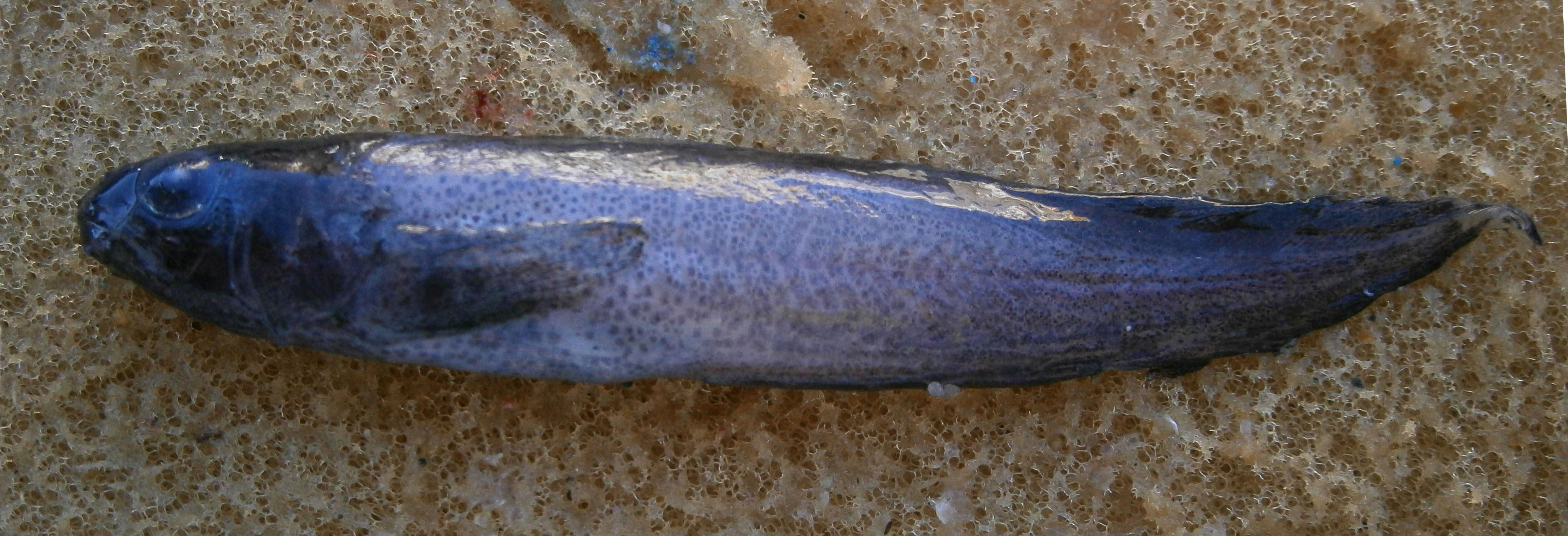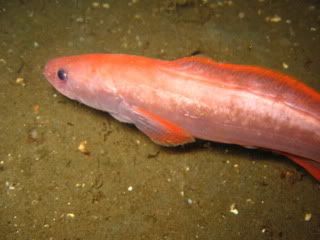
Ogilbia cayorum
FAMILY
Bythytidae
TAXONOMY
Ogilbia cayorum Evermann and Kendall, 1898, Key West,
Florida, United States. The holotype is a female. It was unknown
at the time of the original description that the species is
sexually dimorphic. Thus, considerable taxonomic confusion
occurred when the male of the species was described separately.
Taxonomic confusion persists, since it is believed currently
that numerous undescribed Ogilbia species reside in the
western tropical Atlantic Ocean. The extent to which their
DISTRIBUTION
s
overlap with the Key brotula is unknown. Thus, care
must be taken in identification.
OTHER COMMON NAMES
English: West Indies brotula.
PHYSICAL CHARACTERISTICS
A small and moderately elongate ophidiiform fish with long
anal and dorsal fins. The body and fins are uniformly pigmented,
appearing yellow to olive-brown. Adults can attain
about 3.9 in (10 cm) in length. The caudal fin is distinct and
separate, not confluent with the dorsal- and anal-fin bases. The
pelvic fins are positioned at the isthmus, anterior to the pectoralfin
bases. Each pelvic fin has one fleshy ray that is longer than
the length of the head. The eye is small and the mouth large,
with the upper jaw extending well posterior to the eye. The
body is covered with small overlapping scales that do not appear
on the cheeks (opercular bones).
DISTRIBUTION
The species is known from the Florida Keys, the Bahamas, and
other localities in the Caribbean, including Belize, Cuba,
Puerto Rico, and Jamaica south to Venezuela. Many of these
DISTRIBUTION
al records may be for undescribed and similar
species with overlapping
DISTRIBUTION
s in this region.
HABITAT
The holotype of the Key brotula was collected by seine on an
algae-covered shoal over coral rubble. The coral fragments were
encrusted with organisms. The species usually is collected at
depths of less than 9.8 ft (3 m), often by uprooting and shaking
clumps of Halimeda. This secretive bythitid also may reside in
reef crevices, rocky holes, and mangrove roots in shallow waters
and out to the edge of the reef. It is rarely seen by divers and
typically is collected only in research surveys at poison stations,
sometimes locally abundant. For example, more than 15 individuals
were collected at one station in Belize. The species probably
is tolerant of large fluctuations in temperature and salinity.
BEHAVIOR
Specimens kept in aquaria constantly hide under shells or rubble.
The species probably is nocturnal, judging by its small eyes
and cryptic nature. There are few data on its natural habits.
FEEDING ECOLOGY AND DIET
There are no detailed studies of the diet or feeding
BEHAVIOR
of
this species. Juvenile and adult Key brotulas probably eat small
crustaceans and are preyed upon by larger fishes and wading
birds. Embryonic nutrition is remarkable. To supplement energy
reserves in yolk sacs, embryos of Key brotula “suckle” on
fluid-filled bulbs of ovigerous tissue. This highly unusual developmental
strategy may be an evolutionary response to the
poor feeding evironment of larvae after hatching.
REPRODUCTIVE BIOLOGY
Males and females have delicate, interlocking copulatory organs.
Genital morphological features have been described in detail,
but mating has never been observed. The copulatory apparatus
of the male is partly calcified and is thought to be derived from
the first anal ray. The penis rests on a pedestal surrounded by
muscular pseudoclaspers and covered by a fleshy urogenital
hood. The urogenital pore of the female is similarly protected.
Most bythitids have the capability of sperm storage in the
oviduct or ovary. Fertilization is internal, and embryos grow
rapidly. Late embryos are well developed, with pigmented eyes
and fully developed and functional digestive system, musculature,
gills, and caudal fin. Newborn young are about 0.5 in (12
mm) in length, and brood size is about 14 individuals.
CONSERVATION STATUS
Not listed by the IUCN.
SIGNIFICANCE TO HUMANS
This species is rarely observed and is not fished commercially.
It has limited appeal as an aquarium species, since it rarely
shows itself to the viewer.
Other popular Animals
Photo Gallery of - Key brotula





 Animalia Life
Animalia Life